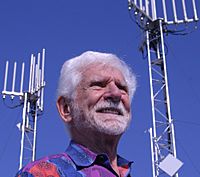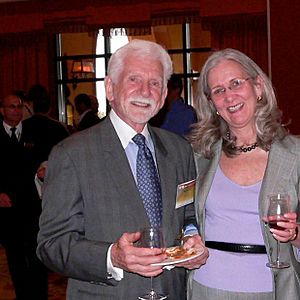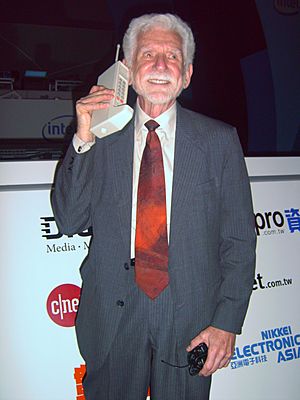Martin Cooper (inventor) facts for kids
Quick facts for kids
Martin Cooper
|
|
|---|---|

Cooper in 2007
|
|
| Born | December 26, 1928 |
| Other names | Marty Cooper |
| Education | Illinois Institute of Technology (BS, MS) |
| Occupation |
|
| Known for | Inventor of the first handheld cellular mobile phone |
| Title | Motorola Founder & CEO of ArrayComm Co-founder and chairman of Dyna LLC |
| Spouse(s) |
Arlene Harris
(m. 1991) |
| Awards | Marconi Prize (2013), ITU 150 Awards (2015) |
Martin Cooper (born December 26, 1928) is an American engineer. He is a true pioneer in the world of wireless communications. He holds eleven patents for his work in managing how radio signals are used.
On April 3, 1973, Cooper made history. While working at Motorola, he placed the first public call from a handheld portable cell phone. He made this call from a sidewalk in Manhattan to a competitor at Bell Labs. Cooper is known for inventing this first handheld cellular mobile phone in 1973. He then led the team that developed it further and brought it to the market in 1983. Because of his amazing work, he is often called the "father of the cell phone". He received the 2015 IEEE Masaru Ibuka Consumer Electronics Award for this invention.
Cooper has also co-founded many communications companies with his wife and business partner, Arlene Harris. He is currently the co-founder and Chairman of Dyna LLC in Del Mar, California. Cooper also helps advise important groups like the U.S. Federal Communications Commission and the United States Department of Commerce.
In 2010, Cooper became a member of the National Academy of Engineering. This honor recognized his leadership in creating and making the portable handheld cell phone widely available.
Contents
Martin Cooper: The Father of the Cell Phone
Early Life and Education
Martin Cooper was born in Chicago. His parents were immigrants from Ukraine. He studied at the Illinois Institute of Technology (IIT) and earned his bachelor's degree in 1950. After college, he served in the military as a submarine officer during the Korean War.
In 1957, he earned his master's degree in electrical engineering from IIT. Later, in 2004, IIT gave him an honorary doctorate degree. He continues to serve on the university's board of trustees.
A Career at Motorola
Cooper started his career at Motorola, Inc. in 1954. He worked as a senior development engineer. One of his early projects was creating a portable handheld radio system for the Chicago police department in 1967. This system was similar to early cell phone technology.
By the early 1970s, Cooper was leading Motorola's communications systems division. This is where he came up with the idea for the first portable cell phone in 1973. He then spent 10 years leading the team to bring this invention to people. Before this, Car phones existed but were only used in a few large U.S. cities. Cooper believed that cell phones should be personal. He imagined a phone number belonging to a person, not a place like a car or a house.
Inventing the First Portable Phone
Motorola's leaders supported Cooper's idea. They invested a lot of money to make his mobile phone concept a reality. Cooper quickly put together a team that designed and built a working phone in less than 90 days.
This first phone was called the DynaTAC 8000x. It was quite large and heavy, weighing about 2.5 pounds (1.1 kg) and measuring 10 inches (25 cm) long. People sometimes called it "the brick" or "the shoe" phone because of its size. A big part of its weight came from the battery. This battery was much heavier than those in phones today. The phone only offered 30 minutes of talk time before needing a 10-hour recharge! Cooper joked that the battery life wasn't a problem because "you couldn't hold that phone up for that long!" By 1983, after several improvements, the phone's weight was cut in half.
Cooper is listed as the main inventor on the patent for this "radio telephone system." The patent was filed in 1973.
The Historic First Call
On April 3, 1973, Cooper and his manager, John Francis Mitchell, showed off two working phones. They demonstrated them to the media and people passing by in New York City. Standing on Sixth Avenue, Cooper made the first public handheld cellular phone call. He used the prototype DynaTAC phone. The call connected him to a special base station Motorola had set up.
Cooper dialed the number of his main competitor, Dr. Joel S. Engel, at AT&T. He famously said, "Joel, this is Marty. I'm calling you from a cell phone, a real handheld portable cell phone." This public demonstration was so exciting that the DynaTAC appeared on the cover of Popular Science Magazine in July 1973. Cooper remembers making many calls that day. He even crossed the street while talking to a radio reporter, calling it "one of the most dangerous things I have ever done in my life."
This first cell phone changed how people thought about phone calls. It shifted the idea from calling a specific place to calling a specific person. Before this, Bell Labs had introduced cellular communication in 1947, but their systems were only for car phones. These car phones needed about 30 pounds (12 kg) of equipment in a car's trunk. Motorola's work helped the Federal Communications Commission (FCC) allow different companies to offer cellular services. This prevented one company, AT&T, from having a complete monopoly.
Cooper worked at Motorola for 29 years. He helped build and manage their paging and cellular businesses. He also played a key role in developing other technologies. These included trunked mobile radio, liquid crystal displays, and various mobile and portable two-way radio products. He became Vice-President and Corporate Director of Research and Development at Motorola.
Beyond Motorola: New Companies

Dyna LLC and GreatCall
In 1986, Cooper and his wife, Arlene Harris, founded Dyna LLC. This company became a home base for developing and supporting new businesses. From Dyna LLC, they launched companies like Subscriber Computing Inc., Cellular Pay Phone, Inc. (CPPI), SOS Wireless Communications, and Accessible Wireless. The last two companies helped create GreatCall.
From his Dyna headquarters, Cooper continues to write and give talks about wireless communications. He also advises government groups, including the U.S. Department of Commerce Spectrum Advisory Committee.
GreatCall, Inc. was co-founded by Cooper in 1986. It created the Jitterbug cell phone in partnership with Samsung. GreatCall was one of the first companies to focus on making cell phones simple and easy to use, especially for senior citizens.
Smart Antennas with Arraycomm
In 1992, Cooper co-founded Arraycomm. This company develops special software for mobile antenna technologies. Under his leadership, Arraycomm grew into a world leader in "smart antenna" technology. It holds hundreds of patents around the globe.
Cooper's Law: Wireless Growth
Cooper noticed a pattern in wireless communication. He found that the ability to send different radio messages at the same time and in the same place has grown steadily since Guglielmo Marconi's first radio transmissions in 1895.
This observation led Cooper to create Cooper's Law. This law states that the maximum number of voice calls or similar data messages that can be sent using all available radio spectrum in a certain area doubles every 30 months. It shows how quickly wireless technology improves over time.
Awards and Achievements
Martin Cooper has received many awards and honors for his groundbreaking work:
- 1984 – IEEE Centennial Medal and Fellow
- 2000 – Inducted as an Inaugural Member of the RCR Wireless News Wireless Hall of Fame
- 2002 – Received the American Computer Museum George Stibitz Computer and Communications Pioneer Award
- 2009 – Received the Prince of Asturias Award for scientific and technical research
- 2010 – Became a Member of the National Academy of Engineering
- 2011 – Received a Webby Award for Lifetime Achievement
- 2013 – Awarded the Charles Stark Draper Prize by the National Academy of Engineering
- 2013 – Received the prestigious Marconi Prize
- 2013 – Received an honorary doctorate from Hasselt University
- 2025 – Received the National Medal of Technology and Innovation
- Also received the Marconi Society Lifetime Achievement Award.
See also
 In Spanish: Martin Cooper para niños
In Spanish: Martin Cooper para niños


